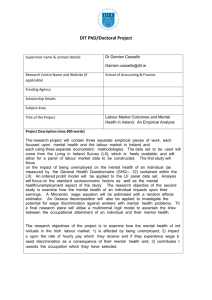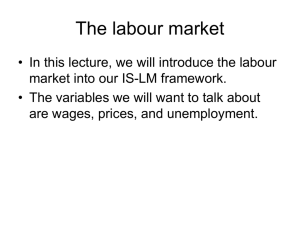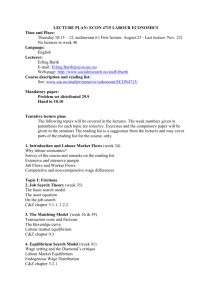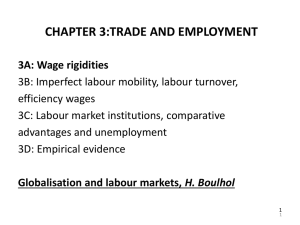Labour HL Template
advertisement
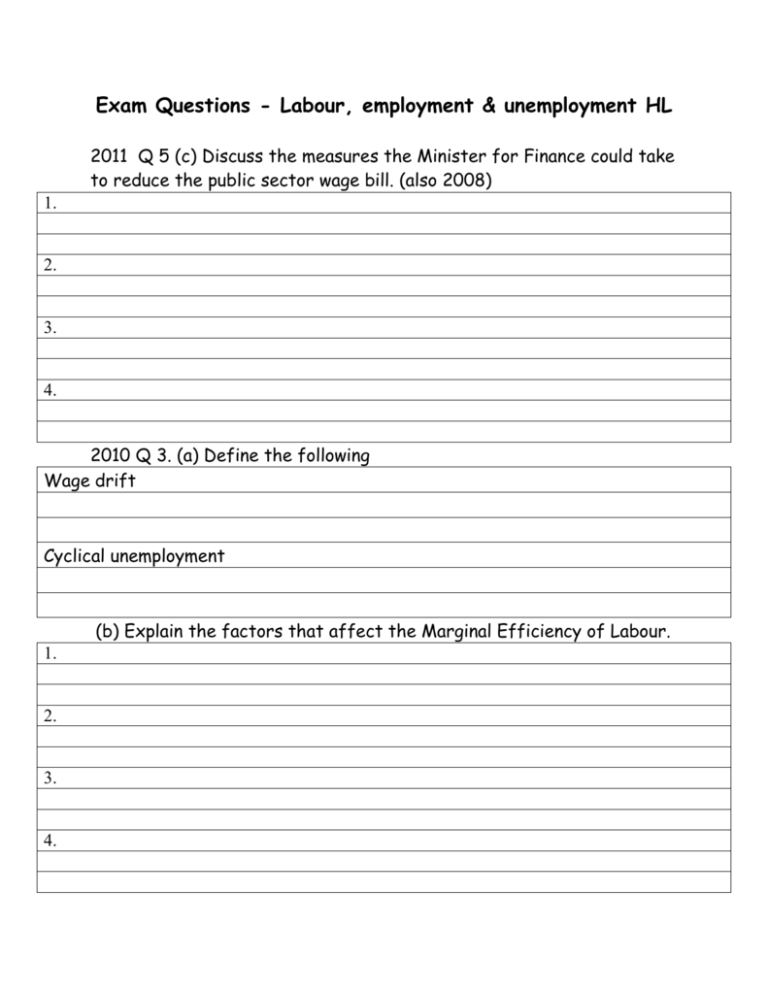
Exam Questions - Labour, employment & unemployment HL 2011 Q 5 (c) Discuss the measures the Minister for Finance could take to reduce the public sector wage bill. (also 2008) 1. 2. 3. 4. 2010 Q 3. (a) Define the following Wage drift Cyclical unemployment (b) Explain the factors that affect the Marginal Efficiency of Labour. 1. 2. 3. 4. (c) Advantages to the Irish economy of reducing the minimum wage. 1. 2. 3. (c) Disadvantages to the Irish economy of reducing the minimum wage. 1. 2. 3. 2009 Q 8 (a) Discuss the factors that influence the size of the Irish labour force. (also 2007 Q 3. (b)) 1. 2. 3. 4. (b) (i) Name a source, other than the QNHS, for unemployment statistic in Ireland. (b) (ii) State, with reason, which of the measures of unemployment used by each of these sources gives the most accurate estimate of Irish unemployment. 1. 2. 3. 4. (c) (i) Outline the major causes of the current increases in unemployment in the Irish economy. 1. 2. 3. 4. 5. (c) (ii) Discuss economic policies which the Irish government might pursue in order to reduce the level of unemployment. 1. 2. 3. 4. 5. 2008 Q 3. (c) Public services are labour intensive and as a consequence the public sector wage bill accounts for a significant proportion of government current spending. (c) (i) Explain why MRP might not be a suitable method for settling wages in the Public Sector. (also 2001 Q 4. (b)) 1. 2. 3. 4. 5. (c) (ii) Outline an alternative method for determining wage levels in the Public Sector wage bill. 1. 2. 3. 4. 5. 2007 Q 3 (a)(ii) Outline five developments, other than a fall in MRP, which may result in a firm reducing its number of employees. 1. 2. 3. 4. 5. (c) (i) Distinguish between occupational & geographical mobility of labour (also 2011) 1. 2. (c) (ii) Outline the economic policies which could increase either occupational or geographical mobility of labour in Ireland. Occupational Mobility 1. 2. 3. Geographical Mobility 1. 2. 3. 2003 Q 4 (a) Define the following. 1. Supply price of a factor of production 2. Transfer earnings 3. Economic Rent (b) (ii) Discuss the factors other than MRP, which influence the demand for labour by an individual firm. (also 1997 Q 3. (b)) 1. 2. 3. 4. 5. (i) Shift left, work less hours @ all wage rates. (i) Backward bending, after a certain wage rate, less hours will be worked as workers can afford to work less or their leisure time is more valuable. (ii) If a minimum wage level is set at We then no labour will be supplied below this wage rate or portion AB of the supply curve of labour will no longer app 2001 Q 4. (a) (ii) Discuss the factors, other than the MRP which influence the wage rates paid to different categories of workers. 1. 2. 3. 4. 5. (c) D > S not relevant at the moment. If S > D = unemployment. 2000 Q 3. (c) Explain the marginal cost of labour. Labour force increased from 5 to 6 employees. Wage rate increased from 200 to 230. Calculate the MCL (1997) 1997 Q 3. (a) Which gives a more accurate picture of the true level of unemployment the Labour Force Survey or the Live Register? 1. 2. 3. 4. 5. HIGHER LEVEL SHORT QUESTIONS YEAR QUESTION 2010 7 2008 1 2007 6 2006 3 2003 9 2002 3





